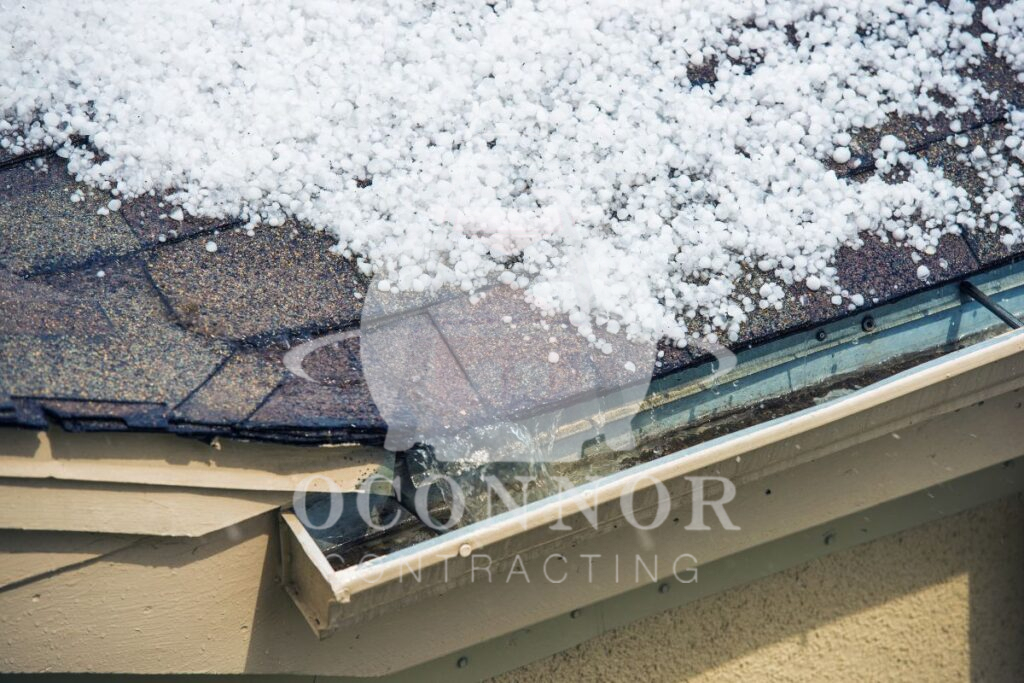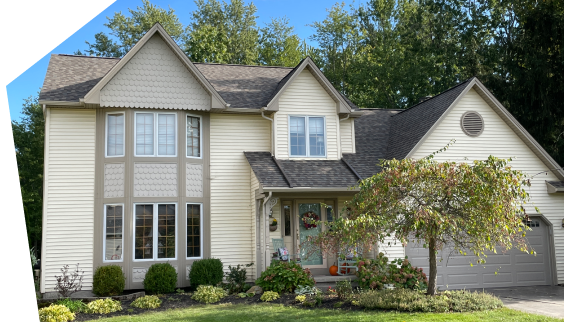As a homeowner, it’s crucial to be aware of the potential damage your roof may experience. Two common problems, roof blistering and hail damage, often look similar but have distinct causes and consequences. By understanding what causes them, how they appear, and the resulting issues, you’ll be better equipped to identify the correct type of damage and take effective measures to repair and prevent future problems.
Let’s delve into this blog post to understand the difference between roof blistering vs. hail damage.
The Difference Between Roof Blistering vs. Hail Damage
What is Roof Blistering?
A common issue in roofing, roof blistering, happens when bubbles or blisters form on the roof’s surface. This is usually due to trapped moisture or air pockets between the roofing material and the underlying layers, which can be caused by improper installation, material damage, or UV radiation exposure. As moisture or air accumulates, it lifts the roofing material, compromising the roof’s integrity and causing additional damage.

Causes
- Poor Ventilation: Inadequate attic airflow often causes overheating, leading blister formation.
- Excess Moisture: Trapped moisture between roof layers or under shingles can create blisters.
- Defective Shingles: Manufacturing flaws like uneven asphalt or poor adhesion between shingle layers increase blister risk.
- Incorrect Installation: Mistakes like incorrect nail placement or improper underlayment contribute to blistering.
- High Heat: Prolonged exposure to intense heat can damage roofing materials, causing blisters.
Consequences Of Ignoring Roof Blistering
- Water Damage: Blisters can let water seep in, causing costly damage to roofs, walls, and ceilings, and potentially even structural collapse.
- Mold Growth: Neglecting blisters can result in water intrusion, creating a breeding ground for mold and mildew and requiring expensive remediation.
- Structural Weakening: Ignored blisters weaken roofs, leading to structural issues like rotting wood and risking collapse.
- Voided Warranties: Ignoring maintenance that could have prevented blisters can void warranties, leaving owners liable for costly repairs or replacements.
- Health Hazards: Mold from blisters can cause serious health issues, particularly for those with respiratory problems or weak immune systems.
- Energy Inefficiency: Neglected blisters compromise insulation, increasing heating and cooling costs.
- Fire Risks: Leaks from blisters can short electrical wires, posing a fire hazard.
What is Hail Damage?
Hail damage occurs when hailstones strike the roof, causing dents, cracks, and punctures that are often more severe than roof blisters. This damage affects various roof components, including shingles, gutters, downspouts, vents, and flashing. The damage can range from minor dents to severe issues like cracked or dislodged shingles and granule loss. Larger hailstones cause more extensive damage, making professional help necessary.

Causes
- Hailstone Size and Impact: Even small hailstones can cause damage due to the impact force, while larger hailstones can lead to severe roof damage because of their size and weight.
- Force and Speed of Hailstones: The speed and force of hailstones can amplify the extent of roof damage, with high-velocity hailstones causing more substantial harm and deeper dents in the shingles.
Consequences Of Ignoring Hail Damage
- Missing or Cracked Shingles: Hailstones can dislodge or crack shingles, allowing water entry and potentially causing mold growth.
- Air Escaping: Damaged shingles allow warm air to escape, increasing heating costs and creating a drafty interior.
- Increased Repair Costs: Neglected hail damage can result in pricier repairs or even necessitate full roof replacement.
- Water Leaks: Leakage into attics or storage areas can escalate damage and repair expenses.
- Mold Growth: Water infiltration from leaks fosters mold growth, posing health risks and causing additional harm.
- Shingle Brittleness: UV exposure and temperature fluctuations can weaken shingles, leading to more damage and cracking.
- Increased Risk of Future Damage: Neglecting hail damage raises the likelihood of further harm in subsequent storms.
Identifying Signs Of Hail Damage vs. Blistering
Hail Damage
1. Dented or Cracked Shingles:
Hailstones can leave visible marks or indentations on asphalt shingles.
2. Loss of Granules:
Hail may dislodge granules from shingles, revealing the material beneath.
3. Fractured or Punctured Roofing Materials:
In severe cases, hailstones can cause shingles or other roofing materials to crack or break.
Roof Blisters
1. Raised Areas on the Roof:
Keep an eye out for bulging or raised sections on the roof surface, which could indicate the presence of blisters.
2. Bubbling:
Small bubbles or blisters may be visible underneath the roofing material, especially after storms or exposure to extreme temperatures.
3. Soft Spots:
When walking on the roof, pay attention to areas that feel soft or spongy underfoot, as this could suggest the presence of underlying blisters.
Distinguishing Between Roof Blistering and Hail Damage
| CHARACTERISTICS | HAIL DAMAGE | ROOF BLISTERING |
| Visual Appearance | Dark spots, dimples, or larger dents on the roof surface | Small bubbles or raised areas on shingles |
| Distribution Pattern | Typically widespread and following the path of the hailstorm | Often localized or spread unevenly across the roof |
| Response to External Factors | Size and shape of damage do not change unless faced with more hail or external damage | Can change with fluctuating temperatures, such as expanding or bursting due to heat |
| Size and Shape | Circular shaped, around the same size | Larger and more irregular sizes and shapes |
| Number | Multiple spots | Typically one or two blisters |
| Depth | Can penetrate through the roofing material | Shallower and more surface-level |
Will Insurance Cover The Cost Of Repairing Roof Blistering or Hail Damage?
Your insurance might cover repairing roof blistering or hail damage, but it all depends on the cause of the damage and your insurance policy.
Hail Damage
- Insurance Coverage: If the damage is due to hail, your homeowner’s insurance could help with the repair costs, given you’ve maintained regular upkeep. You’ll need to file a claim with your insurer, who will send an inspector to evaluate the damage and determine the validity of your claim.
- Costs: Repairing hail damage can run anywhere from $200 to $30,000, depending on the severity.
Roof Blistering
- Insurance Coverage: Homeowner’s insurance typically doesn’t cover roof blistering, seeing it as wear and tear or a manufacturing issue. Your best chance for coverage is through workmanship or manufacturer warranty, if applicable.
- Costs: The cost of repairing blisters varies depending on the extent of the damage and necessary fixes, like replacing shingles or addressing ventilation or moisture problems.
Conclusion
Differentiating between roof blistering and hail damage is crucial for ensuring proper repairs and successfully navigating insurance claims. While both issues appear to be similar on the surface, understanding their distinct characteristics and causes is critical to properly addressing them.
For the best roofing services, choose OConnor Contracting. With years of experience and a commitment to excellence, we offer quality roof repairs and replacements for all your roofing needs. Call us today at (716) 600-7663 for expert roofing solutions.


